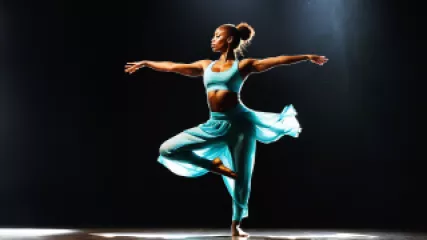The 10 Best Virtual Movement Classes for Dance Movement Therapy
The 10 Best Virtual Movement Classes for Dance Movement Therapy
In the realm of dance movement therapy, virtual movement classes have emerged as a powerful tool for individuals seeking to explore the transformative power of movement and self-expression. As the world has become increasingly digitized, the demand for accessible and innovative ways to engage in dance therapy has skyrocketed. In this comprehensive list, we'll delve into the 10 best virtual movement classes that are revolutionizing the field of dance movement therapy.
1. Kaleidoscope of Movement with Aubrey Ford
Aubrey Ford's "Kaleidoscope of Movement" virtual classes offer a captivating journey through various dance styles and somatic practices. Drawing from her extensive background in dance movement therapy, Aubrey guides participants through a kaleidoscope of movement experiences, each one designed to unlock new pathways for self-exploration and personal growth.
Participants in Aubrey's classes can expect a dynamic blend of contemporary dance, improvisation, and mindfulness-based exercises. The sessions are structured to encourage embodied self-expression, with a focus on cultivating a deep connection between the mind, body, and emotions.
Whether you're a seasoned dancer or new to the world of movement, Aubrey's classes provide a safe and supportive space to delve into the healing power of dance. Through guided imagery, breath work, and thoughtful reflections, each class becomes a transformative experience, empowering participants to reconnect with their inner landscapes and find new avenues for personal transformation.
2. Rhythmic Resonance with Craig Carter
Craig Carter's "Rhythmic Resonance" virtual movement classes offer a unique blend of African-inspired dance, drumming, and somatic exploration. With a deep understanding of the connection between rhythm, movement, and emotional well-being, Craig guides participants through a captivating journey of self-discovery.
Each class session begins with a grounding practice, inviting participants to become present and align their physical, mental, and emotional states. From there, the class delves into a rhythmic exploration, using the power of drumming and movement to unleash the body's natural ability to express itself.
Throughout the experience, Craig weaves in elements of African dance traditions, encouraging participants to embrace the wisdom of the body and the transformative potential of communal movement. Whether you're seeking to deepen your connection with your cultural heritage or simply explore the therapeutic benefits of rhythm and dance, Craig's "Rhythmic Resonance" classes provide a truly enriching and empowering experience.
3. Embodied Storytelling with Kaliyah Edwards
Kaliyah Edwards' "Embodied Storytelling" virtual movement classes offer a captivating exploration of the intersection between movement, narrative, and personal growth. Drawing from her background in dance therapy and creative writing, Kaliyah guides participants through a journey of self-expression, using the language of the body to unlock the stories that reside within.
Each class session begins with a warm-up focused on mindfulness and somatic awareness, preparing the body and mind for the creative journey ahead. Participants are then invited to engage in guided improvisations, using movement as a means of exploring personal narratives, emotions, and experiences.
Through the use of imagery, metaphor, and collaborative storytelling, participants in Kaliyah's classes are empowered to give voice to their inner worlds, using the transformative power of dance to heal, grow, and connect with themselves and others on a deeper level.
4. Fluid Fusion with Allen Smith
Allen Smith's "Fluid Fusion" virtual movement classes blend the principles of dance, yoga, and Pilates to create a truly unique and transformative experience. Rooted in the belief that movement is a powerful tool for self-discovery and personal growth, Allen's classes invite participants to explore the fluidity and interconnectedness of the body, mind, and spirit.
Each session begins with a grounding practice, allowing participants to sink into the present moment and become fully attuned to their physical sensations. From there, the class unfolds as a harmonious fusion of dynamic dance sequences, restorative yoga poses, and Pilates-inspired core work, all designed to promote a sense of embodied well-being.
Throughout the experience, Allen encourages participants to move with intention, focusing on the breath and the subtle nuances of each movement. The result is a deeply nourishing and rejuvenating practice that not only strengthens the body but also cultivates a profound sense of inner peace and self-awareness.
5. Movement Meditations with Aubrey Ford
Aubrey Ford's "Movement Meditations" virtual classes offer a unique and transformative approach to dance movement therapy, combining the power of mindfulness, somatic awareness, and expressive movement.
Each class session begins with a guided meditation, inviting participants to turn their attention inward and become fully present with their physical, mental, and emotional states. From this grounded foundation, Aubrey leads the group through a series of movement explorations, encouraging participants to let their bodies speak the language of their inner landscapes.
Through the use of imagery, symbolic gestures, and improvisation, participants in Aubrey's "Movement Meditations" classes are empowered to tap into the depths of their subconscious, unlocking new avenues for self-expression, emotional processing, and personal transformation.
Whether you're seeking to deepen your mindfulness practice, explore the therapeutic benefits of dance, or simply reconnect with the wisdom of your body, Aubrey's "Movement Meditations" classes offer a profoundly enriching and nourishing experience.
6. Rhythmic Revolutions with Craig Carter
Craig Carter's "Rhythmic Revolutions" virtual movement classes invite participants to embark on a journey of self-empowerment and cultural celebration. Drawing from his extensive background in African dance, drumming, and somatic practices, Craig guides participants through a dynamic exploration of rhythm, movement, and the transformative power of community.
Each class session begins with a grounding practice, allowing participants to center themselves and become fully present. From there, the class delves into a rhythmic exploration, using drumming, call-and-response, and shared movement to cultivate a sense of collective energy and mutual support.
As the class progresses, participants are encouraged to let go of inhibitions, embrace the power of their bodies, and tap into the liberating potential of communal expression. Through this process, individuals are empowered to reclaim their cultural heritage, confront societal norms, and celebrate the inherent dignity and resilience of the human spirit.
Whether you're seeking to deepen your connection with your cultural roots, explore the therapeutic benefits of rhythm and dance, or simply engage in a transformative and empowering movement practice, Craig's "Rhythmic Revolutions" classes offer a truly enriching and life-affirming experience.
7. Embodied Journeys with Kaliyah Edwards
Kaliyah Edwards' "Embodied Journeys" virtual movement classes invite participants to embark on a profound exploration of the self through the medium of dance and storytelling. Drawing from her expertise in dance therapy and creative writing, Kaliyah guides individuals through a series of guided movement explorations, each one designed to uncover the unique narratives that reside within the body.
Each class session begins with a warm-up focused on somatic awareness and mindfulness, preparing the body and mind for the creative journey ahead. Participants are then invited to engage in improvised movement sequences, using their bodies as a canvas to express their innermost thoughts, emotions, and life experiences.
Throughout the process, Kaliyah weaves in elements of narrative therapy, encouraging participants to reflect on their personal stories and explore new avenues for self-expression. The result is a deeply transformative experience that empowers individuals to reclaim their personal narratives, foster self-acceptance, and cultivate a deeper understanding of their own lived experiences.
Whether you're seeking to heal from past trauma, explore the complexities of your identity, or simply engage in a profoundly meaningful movement practice, Kaliyah's "Embodied Journeys" classes offer a truly enriching and empowering experience.
8. Fluid Fusion Revived with Allen Smith
Allen Smith's "Fluid Fusion Revived" virtual movement classes build upon the principles of his signature "Fluid Fusion" practice, offering a revitalized and deeply nourishing approach to dance movement therapy.
Each class session begins with a grounding meditation, allowing participants to settle into the present moment and become fully attuned to their physical, mental, and emotional states. From this foundation, the class unfolds as a harmonious blend of dynamic dance sequences, restorative yoga poses, and Pilates-inspired core work, all designed to promote a profound sense of embodied well-being.
Throughout the experience, Allen encourages participants to move with intention, focusing on the breath and the subtle nuances of each movement. The result is a deeply rejuvenating practice that not only strengthens the body but also cultivates a sense of inner peace, self-awareness, and personal growth.
Whether you're a seasoned practitioner of dance, yoga, or Pilates, or simply seeking a holistic approach to movement and self-exploration, Allen's "Fluid Fusion Revived" classes offer a truly transformative experience.
9. Rhythmic Renewal with Craig Carter
Craig Carter's "Rhythmic Renewal" virtual movement classes offer a unique and empowering approach to dance movement therapy, blending the power of African-inspired dance, drumming, and somatic exploration.
Each class session begins with a grounding practice, allowing participants to center themselves and become fully present with their physical, mental, and emotional states. From this foundation, the class delves into a rhythmic exploration, using the energy of drumming and shared movement to cultivate a sense of community, self-expression, and personal transformation.
Throughout the experience, Craig encourages participants to embrace the wisdom of their bodies, letting the rhythm and movement guide them on a journey of self-discovery. Whether you're seeking to deepen your connection with your cultural heritage, explore the therapeutic benefits of rhythm and dance, or simply engage in a profoundly empowering movement practice, Craig's "Rhythmic Renewal" classes offer a truly enriching and life-affirming experience.
10. Embodied Awakenings with Kaliyah Edwards
Kaliyah Edwards' "Embodied Awakenings" virtual movement classes offer a profound and transformative exploration of the self through the medium of dance and storytelling. Drawing from her expertise in dance therapy and creative writing, Kaliyah guides participants on a journey of self-discovery, empowering them to uncover the unique narratives that reside within their bodies.
Each class session begins with a warm-up focused on somatic awareness and mindfulness, preparing the body and mind for the creative journey ahead. Participants are then invited to engage in a series of guided movement explorations, using improvisation and symbolic gestures to express their innermost thoughts, emotions, and life experiences.
Throughout the process, Kaliyah weaves in elements of narrative therapy, encouraging participants to reflect on their personal stories and explore new avenues for self-expression. The result is a deeply transformative experience that empowers individuals to reclaim their personal narratives, foster self-acceptance, and cultivate a deeper understanding of their own lived experiences.
Whether you're seeking to heal from past trauma, explore the complexities of your identity, or simply engage in a profoundly meaningful movement practice, Kaliyah's "Embodied Awakenings" classes offer a truly enriching and empowering experience.
In conclusion, the virtual movement classes highlighted in this list offer a diverse and transformative approach to dance movement therapy, empowering individuals to explore the healing power of movement, self-expression, and personal growth. From the rhythmic explorations of Craig Carter to the embodied storytelling of Kaliyah Edwards, each class provides a unique opportunity for participants to connect with their bodies, unlock their inner narratives, and engage in a deeply nourishing and transformative practice.
As the world continues to navigate the challenges of the digital age, these virtual movement classes serve as a beacon of hope, connecting individuals across geographical boundaries and offering a gateway to the profound healing and self-discovery that dance movement therapy can provide. Whether you're a seasoned practitioner or new to the world of movement, these classes offer a rich and rewarding experience that can have a lasting impact on your physical, mental, and emotional well-being.
So, embark on a journey of self-discovery, embrace the fluidity of movement, and let the rhythms of the body guide you towards a deeper understanding of yourself and the world around you. Immerse yourself in the transformative power of virtual movement classes and unlock the boundless potential that lies within.






